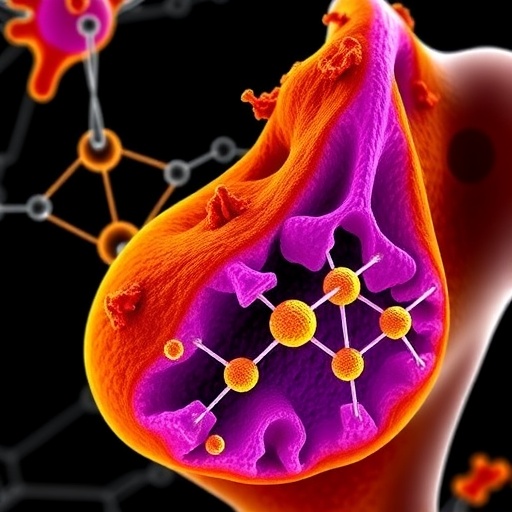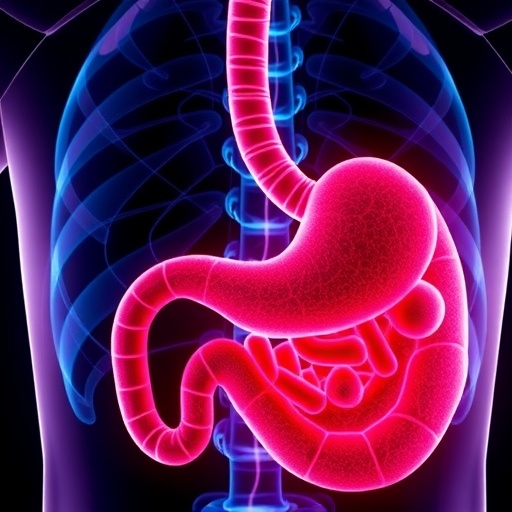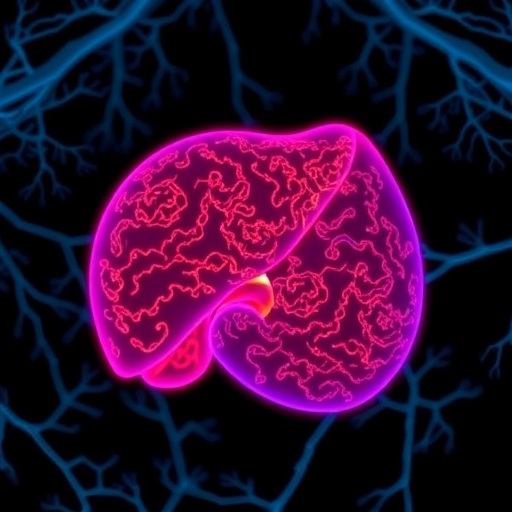
In the relentless pursuit of more effective cancer therapies, recent research has illuminated a promising avenue through the intricate interplay of nanotechnology and molecular signaling pathways. A groundbreaking study has unveiled the intricate effects of dendrosomal nanocurcumin on the Wnt/β-catenin signaling pathway mediated by PIWIL2 in MCF-7 breast cancer cells, shedding light on novel mechanisms that could redefine future oncological interventions.
Cancer remains a formidable global challenge, with breast cancer being one of the most prevalent and complex forms affecting millions worldwide. Traditional treatments, although advancing, often encounter the hurdles of resistance and adverse side effects. Against this backdrop, researchers have turned to the convergence of bioactive compounds and nanotechnology to enhance therapeutic efficacy while minimizing systemic toxicity. Dendrosomal nanocurcumin, an engineered nanoparticle formulation of curcumin, emerges as a frontrunner due to its improved bioavailability and targeted delivery potential.
Curcumin, a bioactive constituent derived from the turmeric plant, has long been celebrated for its anti-inflammatory and anticancer properties. Yet, its clinical translations have been hampered by poor solubility and rapid metabolic degradation. By encapsulating curcumin within dendrosomes—specialized nanocarriers designed to optimize cellular uptake—the bioactive compound’s stability and intracellular delivery are markedly enhanced, enabling a more potent intervention against malignant cells.
.adsslot_DhTIHWFoez{width:728px !important;height:90px !important;}
@media(max-width:1199px){ .adsslot_DhTIHWFoez{width:468px !important;height:60px !important;}
}
@media(max-width:767px){ .adsslot_DhTIHWFoez{width:320px !important;height:50px !important;}
}
ADVERTISEMENT
Central to the cancer biology explored in this study is the Wnt/β-catenin signaling pathway, a critical regulator of cell proliferation, differentiation, and survival. Dysregulation of this pathway frequently contributes to tumorigenesis and metastasis, making it a compelling target for therapeutic modulation. Aberrant activation of Wnt/β-catenin signaling fosters uncontrolled cellular growth, evasion of apoptosis, and promotes oncogenic transformation within diverse cancer types, including breast cancer.
The study focuses on MCF-7 cell lines, a well-established model of estrogen receptor-positive breast cancer. These cells provide a robust platform to interrogate molecular responses and assess the efficacy of novel therapeutic agents. By treating MCF-7 cells with dendrosomal nanocurcumin, researchers were able to observe notable modulation of the Wnt/β-catenin pathway, unpacking a complex cascade that influences cancer cell fate.
Intriguingly, the protein PIWIL2, part of the PIWI family implicated in stem cell maintenance and gene regulation, emerged as a significant mediator in this molecular dialogue. PIWIL2’s overexpression has been correlated with poor prognosis in various malignancies, including breast cancer, by enhancing tumorigenic potential and facilitating cancer stem cell-like properties. The study elucidates how dendrosomal nanocurcumin exerts its inhibitory effect on the Wnt/β-catenin axis through modulation of PIWIL2, thereby attenuating aggressive cancer phenotypes.
Molecular assessments demonstrated that dendrosomal nanocurcumin decreased the nuclear translocation of β-catenin, a pivotal event for the transcriptional activation of oncogenes within the Wnt pathway. This cytoplasmic retention of β-catenin limits the expression of downstream targets involved in proliferation and survival, effectively curbing tumor growth dynamics. The mechanistic insights gained from these observations highlight the therapeutic promise of targeting intracellular signaling hubs with nanoparticle-delivered natural compounds.
Beyond signaling interference, dendrosomal nanocurcumin also influenced gene expression profiles associated with epithelial-mesenchymal transition (EMT), a key process enabling cancer metastasis. The suppression of EMT markers following treatment underscores the compound’s multifaceted impact, potentially impeding metastatic dissemination and improving clinical outcomes.
What sets this research apart is its innovative approach to harness the synergy between nanotechnology and endogenous molecular regulators. By focusing on dendrosomal formulations, the study addresses long-standing challenges of curcumin’s therapeutic limitations. Moreover, it underscores the significance of PIWIL2 as a therapeutic target, a relatively unexplored avenue that could pave the way for new cancer treatment paradigms.
The translational implications of these findings are profound. Enhancing the delivery and functional activity of curcumin through dendrosomes may enable clinicians to adopt more refined strategies that selectively impair tumor growth mechanisms while sparing normal tissues. This precision approach aligns with the broader goals of personalized medicine, tailoring treatments to the unique molecular landscape of individual tumors.
Furthermore, the study opens avenues for combinatory therapies where dendrosomal nanocurcumin could be paired with existing chemotherapeutics or immune modulators to amplify anticancer responses. By dampening critical signaling pathways and reversing EMT changes, this nanocarrier-mediated therapy holds potential to overcome resistance phenomena often encountered in breast cancer management.
From a technological standpoint, the development of dendrosomal nanocurcumin showcases advances in nanoparticle synthesis techniques that optimize size, biocompatibility, and controlled release profiles. These features collectively contribute to enhanced cellular uptake and sustained therapeutic action, crucial parameters for clinical success.
While the in vitro findings established a promising proof-of-concept, further in vivo studies and clinical trials will be pivotal in validating the safety, pharmacokinetics, and efficacy of dendrosomal nanocurcumin in complex biological systems. Continued research into dosage optimization and potential off-target effects will also determine its readiness for clinical application.
In essence, this study represents a significant stride towards integrating natural product chemistry with cutting-edge nanomedicine to dismantle the molecular underpinnings of breast cancer. By illuminating the crosstalk between dendrosomal nanocurcumin, PIWIL2, and the Wnt/β-catenin pathway, it enriches our understanding and inspires novel therapeutic avenues that could revolutionize patient care.
The implications extend beyond breast cancer, as the molecular pathways involved are conserved across multiple cancer types. Consequently, the therapeutic principles derived here could be adapted and expanded to target other malignancies, amplifying the scope and impact of this research.
As the scientific community continues to grapple with the complexities of cancer biology, studies like this underscore the transformative potential of integrating molecular targeting with innovative drug delivery systems. The marriage of dendrosomal nanocurcumin with Wnt/β-catenin signaling modulation heralds a new era in oncological therapeutics—where precision, efficacy, and natural compound resilience converge.
In conclusion, the unveiling of dendrosomal nanocurcumin’s role in modulating cancer-critical signaling pathways via PIWIL2 not only elevates curcumin’s therapeutic profile but also charts a forward path in the fight against breast cancer. This amalgamation of nanotechnology and molecular biology stands poised to recalibrate the therapeutic landscape, offering renewed hope to patients and clinicians alike.
Subject of Research:
The study investigates the impact of dendrosomal nanocurcumin on the Wnt/β-catenin signaling pathway mediated through the PIWIL2 protein in MCF-7 breast cancer cells.
Article Title:
The effect of dendrosomal nanocurcumin on Wnt/β-catenin signaling pathway via PIWIL2 in MCF-7 breast cancer cells.
Article References:
Ghasri, A., Bahri Hampa, S., Mirzaee Godarzee, M. et al. The effect of dendrosomal nanocurcumin on Wnt/β-catenin signaling pathway via PIWIL2 in MCF-7 breast cancer cells. Med Oncol 42, 381 (2025). https://doi.org/10.1007/s12032-025-02960-6
Image Credits: AI Generated
Tags: anti-inflammatory properties of curcuminbioactive compounds in cancer therapycurcumin bioavailability enhancementdendrosomal nanocurcuminengineered nanoparticles for drug deliveryMCF-7 breast cancer cell studiesnanotechnology in oncologyovercoming cancer treatment resistancePIWIL2 role in cancersystemic toxicity reduction in cancer treatmentstargeted cancer therapy innovationsWnt signaling pathway in breast cancer





